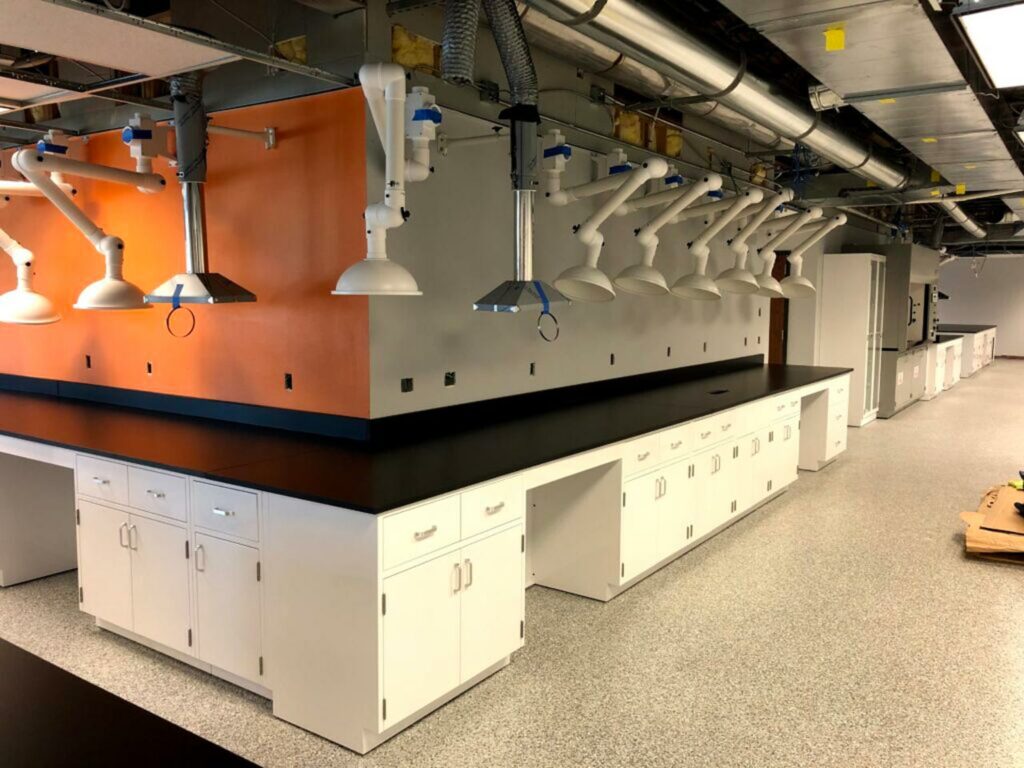Phenol Resin, also known as phenol formaldehyde (PF) resin, is a synthetic polymer-based material that resists water, chemicals, oxidation, and heat. The phenolic resin properties have made it a popular material for laboratory countertops—as well as kitchen and bathroom countertops.
If you’re looking to understand how phenolic resins are made, and what uses there are for phenolic resins, check out the science behind phenol-formaldehyde resins!
Phenolic Resins Introduction
Phenolic resin is the first type of synthetic resin to be mass-produced and used commercially. It is also known as phenolic formaldehyde resin, is produced through a polymerization process, and is commonly used as a low-cost alternative to epoxy resin.
How to make phenolic resin? To do this, one adds a catalyst to a phenol and formaldehyde mixture to create an initial reaction. Afterward, this solution is heated, kick-starting the polymerization process.
Then, additional formaldehyde solution is added to the mixture and more heat is introduced. This mixture will be left to cool—what remains post-curing is a viscous and thick material, known commonly as phenolic resin.
It is a lightweight composite material with water resistance, heat resistance, chemical resistance, and corrosion resistance properties. Its synthetic nature also makes it a more affordable option to epoxy resin.
These make phenolic resin popular, lending itself to a wide variety of applications from molding powders and laminating resins to surface coatings and binders.
Lightweight Composite Materials Processing Phenol Formaldehyde Resin
Lightweight composite materials are fiber-reinforced composites with great strength and low weight.
Given that phenolic resin process excellent properties, yet is incredibly lightweight, makes manufacturers use it when building lightweight composite materials.
Phenolic resin is a versatile material. It can undergo vacuum and oven processing, autoclave processing, high-pressure match-die molding, to convert phenolic resin into raw materials that can be shaped in every which way—or from flat sheets all the way to large contours fitted around vehicle bodies.
The use of lightweight composite materials is usually in manufacturing wearable body protection gear. They’re also commonly used to build protective gear for land and water vehicles, as well as aircraft.
Phenol Formaldehyde Resins
Phenol formaldehyde resin is another term for phenolic resin. The name originates from the manufacturing process of phenolic resin, which includes mixing phenol and formaldehyde with a catalyst.
Compared to other resin types, phenolic-formaldehyde resins have incredible water resistance and chemical resistance, as well as some heat resistance features.
They also bond very well with cellulose fibers, making them a great option for binding hardwoods, plywoods, and other standard boards.
Phenolic Resins in Adhesive and Bonding Applications
Phenolic resin is relatively affordable, and has great resistance to water, heat, and chemicals, and makes for a tough surface. They are also thermoset polymers that transform into an irreversible hard material once cured.
These make them perfect adhesives or bonding agents that can be added to organic and inorganic materials as additional reinforcement.
Today, the phenolic formaldehyde resin is most commonly used as an adhesive or a binding agent for wood and wood products as it has the ability to chemically bond with lignin, a complex oxygen-containing polymer—along with cellulose, composes wood.
Though one can use substituted phenol for wood adhesives, phenolic resin remains a top choice due to its unbeatable bonding strength.
However, given their impressive water and heat resistance quality, they are more costly than Urea-formaldehyde (UF) resin and are more often reserved for outdoor or demanding indoor use.
They’re also a top choice as adhesive in machinery and vehicles. Phenolic resin is mixed with clay and other fillers, as well as some elastomeric resins for increased toughness and peel strength, to create parts, such as brake linings, light bulb bases, and electrical laminates.
Specialty Polymers & Polymer Processing Composites
Special polymers and polymer processing composites are types of resin, mixed and cured to exhibit unusual properties for special applications. Depending on the composition, specialty polymers can exhibit higher tensile strength, thermal stability, viscosity, and water absorption.
An example of a specialty polymer that includes phenolic resin is neoprene-phenolic blends. By combining phenolic-formaldehyde resin with neoprene rubber, one produces a specialty polymer with a high thermal stability of up to 95°C and toughness.
Other specialty polymers that use phenolic resin are phenolic based carbon fibers,
Fiber Reinforced Laminates in Aerospace Engineering
Fiber Reinforced Laminate (FRL) is a type of specialty polymer developed by Panolam to create higher impact resistance.
FRL is created by infusing long and short bundles of natural fiber together through a matrix. The resulting two-dimensional orientation is lightweight and incredibly resistant to high impact.
Such a lightweight composite material makes excellent aerospace parts. The amazing impact resistance of FRL makes it ideal for sustaining fatigue, extending the life of aerospace parts, and limiting the need for repairs and downtime.
Phenolic Resins as a Matrix Material in Advanced Fiber Reinforced Polymer (FRP) Composites
Where alternatives to metal or concrete are needed in construction, advanced fiber-reinforced polymer (FRP) composites with phenolic resins are often used as substitutes.
FRP composites that utilize phenolic formaldehyde resin as matrix material are high in corrosion resistance and freeze-thaw resistance.
Not to mention, FRP composites are resistant to heat and release minimal fume or smoke production when heated. These properties make them preferable to metal or concrete in alkaline conditions or where heat, moisture, and extreme temperature changes take place.
Carbon Fiber Spinning
Carbon fiber is a material made primarily of carbon atoms bonded together to form a long chain. It is incredibly stiff, possesses high tensile strength, has lightweight, and is heat and chemical resistant qualities.
When making carbon fiber, organic polymers are used as precursors. These polymers are then stabilized, carbonized, and slightly oxidized before they are coated.
One of the potential coating materials is phenol formaldehyde resin, which, given its thermal properties, is able to lend carbon fiber some thermal stability. Once coated, the carbon fibers are wound onto cylinders, which are loaded into spinning machines that twist the fibers into yarns.
Phenolic Resin at Affordable Prices
If you’re convinced of how well phenolic resins withstand use conditions, get yourself a phenolic resin countertop at ResinTops. Worry no more about spills, burns, and leaving unwanted stains and marks on your wood surface.
At ResinTops, we specialize in manufacturing high-quality and standard best countertops made of phenolic resin or epoxy resin.
Get a free quote and contact us at ResinTops today!


